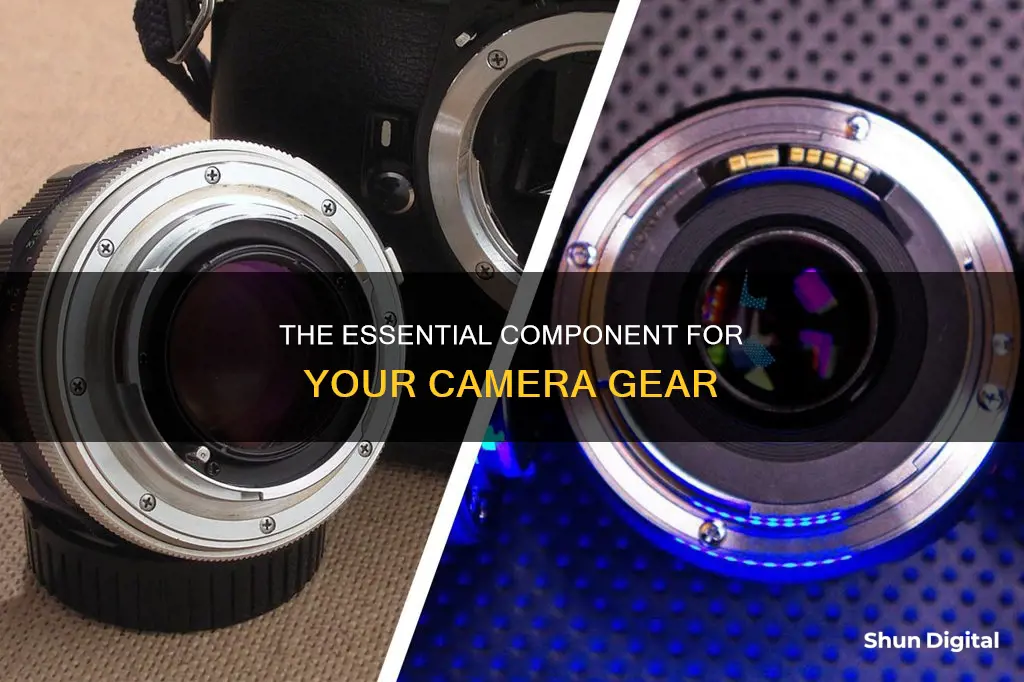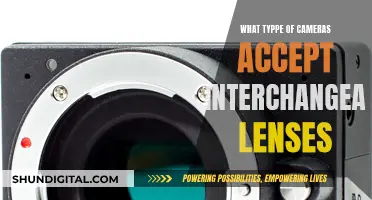
Photography enthusiasts and professionals alike are always on the lookout for ways to improve their craft and enhance their images. One of the most important aspects of achieving this is understanding the various components of a camera and how they work together to capture the perfect shot. One such component is the lens mount, which is the part of the camera that lenses are attached to. In this article, we will delve into the specifics of lens mounts, their functions, and their role in helping photographers capture stunning visuals.
| Characteristics | Values |
|---|---|
| Name | Lens mount |
| Purpose | Mechanical fitting that attaches the lens to the camera |
| Function | Allows communication between the lens and camera |
| Compatibility | Must match the camera; no universal standard |
What You'll Learn
- The part that camera lenses are attached to is called the lens mount
- Lens mounts are designed to fit a specific camera body type
- Each camera manufacturer uses a different lens mount design
- Lens mounts have mechanical linkages and electrical contacts
- The lens mount ring is lined up with small dots on the camera body

The part that camera lenses are attached to is called the lens mount
The part of a camera that camera lenses are attached to is called the lens mount. The lens mount is a metal area that has been machined to fit a specific camera body type. Each camera manufacturer uses a different lens mount design, and some have changed their designs over the years, meaning that older manual camera lenses may not fit newer SLR or DSLR cameras. When purchasing a lens, it is important to ensure that the lens mount matches your camera.
The lens mount contains mechanical linkages and, in some cases, electrical contacts that facilitate the transmission of information between the lens and the camera body. These contacts allow the camera to control the lens.
To attach a lens, you line up the lens mount index on the lens with the mark on the lens mount and gently rotate the lens into place. There is also a lens release button that must be pressed to detach the lens. This acts as a safety measure, as it prevents the lens from being accidentally knocked off.
Different types of lens mounts include the Canon EF, EF-S and EF-M autofocus lens mounts, the Nikon F manual and autofocus mounts, the Pentax K mount, and the Sony Alpha mount, among others.
Are Your Camera Lenses Radioactive? Here's How to Tell
You may want to see also

Lens mounts are designed to fit a specific camera body type
A lens mount is the part of a camera that attaches the lens to the camera body. Lens mounts are designed to fit a specific camera body type, and each camera manufacturer typically uses a unique lens mount design. This means that lenses are often not compatible with different camera brands. The lens mount also contains electrical contacts that allow the camera to control the lens.
When purchasing a lens, it is important to ensure that the lens mount matches your camera body. Some older manual lenses may be compatible with multiple brands, but this is less common today. In addition, some camera manufacturers use proprietary lens mounting systems to ensure that customers use their lenses.
The lens mount is typically located on the front of the camera, near the lens release button. To attach a lens, you line up small dots on the camera body and the lens, then gently rotate the lens into place. The lens release button is used to detach the lens from the camera body.
Lens mounts are an important consideration when choosing a camera and lenses, as they determine the compatibility between the two. Different lens mounts may have different features and capabilities, so it is important to choose a system that meets your photography needs.
The Lifespan of Camera Autofocus Lenses: How Long Do They Last?
You may want to see also

Each camera manufacturer uses a different lens mount design
The part of the camera that lenses are attached to is called the lens mount. Each camera manufacturer uses a different lens mount design, and some have changed their lens mounts over the years, so older manual camera lenses may not fit newer SLR and DSLR cameras. When buying lenses, it is important to ensure that the lens mount matches your camera.
The lens mount is a metal area that has been machined into a particular shape to fit a specific camera body type. It contains contacts that will match up with contacts on the lens ring mount, allowing the camera to control the lens.
To attach a lens to the camera, line up small dots on the camera body and the lens. Then, gently rotate the lens into place.
Understanding the Reach of 800mm Camera Lenses
You may want to see also

Lens mounts have mechanical linkages and electrical contacts
The part of a camera that lenses are attached to is called the lens mount. Lens mounts are usually made of metal and have been machined to fit a specific camera body type. They contain mechanical linkages and often electrical contacts that allow for communication between the lens and the camera body.
Lens mounts are designed to attach lenses to camera bodies. They are typically made of metal and have been shaped to fit a specific camera model. Different camera manufacturers use distinct lens mount designs, and some have changed their designs over time. This means that older manual camera lenses may not be compatible with newer camera models.
Lens mounts contain mechanical linkages that physically connect the lens to the camera body. In addition, they often include electrical contacts that enable communication between the lens and the camera. These contacts, also known as the lens' contacts, are small metal pins located on the back of the lens. When the lens is mounted, these pins align with the camera body, facilitating the exchange of information.
The information conveyed through the electrical contacts includes automatic adjustments such as aperture, focal length, and focus. This allows the camera to control various aspects of the lens electronically, optimising its performance for different shooting scenarios.
The lens mount also plays a crucial role in ensuring the secure attachment of the lens to the camera body. It is designed to allow for easy attachment and detachment of the lens while maintaining a stable connection during use. This stability is essential for clear and sharp images, as it minimises the risk of camera shake or lens movement that could result in blurry photos.
In summary, lens mounts are integral components of a camera system, facilitating the physical connection between the lens and the camera body through mechanical linkages. They also enable electronic communication between the two, allowing for automatic adjustments to settings like aperture and focus. The design of lens mounts varies across camera manufacturers and models, underscoring the importance of compatibility when choosing lenses for a specific camera body.
Capturing Sports: Camera Lens Techniques for Dynamic Shots
You may want to see also

The lens mount ring is lined up with small dots on the camera body
The lens mount is the part of the camera that attaches the lens to the camera body. Each camera manufacturer uses a different lens mount design, and it is important to ensure that the lens mount matches your camera. The lens mount ring is lined up with small dots on the camera body, and the lens is then gently rotated into place. This process involves lining up the lens mount index on the lens with the red mark on the lens mount and turning the lens clockwise until it clicks into place. This ensures a secure connection between the lens and the camera, allowing them to work together seamlessly.
The lens mount plays a crucial role in photography as it enables photographers to attach different lenses to their cameras, offering various creative possibilities. Different lenses have different focal lengths, apertures, and other properties, which can be used to capture a diverse range of images. For example, a wide-angle lens has an angle of view wider than 60 degrees and a focal length shorter than normal, while a telephoto lens has a longer focal length, allowing for a narrower angle of view and closer shots of distant subjects.
In addition to the lens mount, other essential parts of a camera include the viewfinder, shutter, aperture, image sensor, body, and memory card slot. These components work together to capture and store photographs, allowing photographers to express their creativity and capture the world through the lens.
It is worth noting that some cameras have proprietary lens mounting systems, which means that only specific lenses designed for that camera brand will fit. This is an important consideration when purchasing lenses, as it ensures compatibility and seamless functionality between the lens and the camera body.
Packing Camera Gear: Travel-Ready in 10 Minutes
You may want to see also
Frequently asked questions
The part of the camera that attaches to the camera lens is called the lens mount.
A lens mount is a mechanical fitting that allows the lens to attach to the camera. The lens mount has small dots that need to be lined up with the camera body. The lens is then gently rotated into place.
The lens mount connects the camera to the lens, ensuring a secure attachment. It also contains electrical contacts, which allow the camera to control the lens and transmit information between the two.
No, each camera manufacturer typically uses its own proprietary lens mount design. Therefore, it is important to ensure that the lens mount matches your specific camera model when purchasing lenses.







